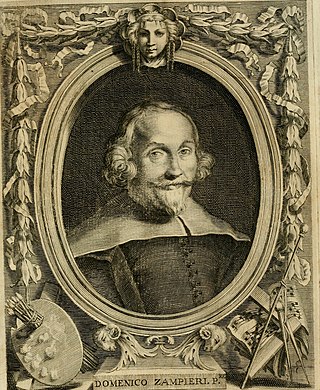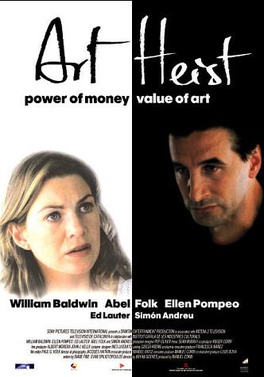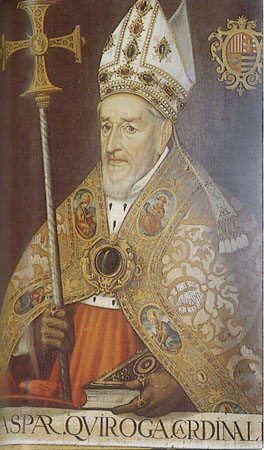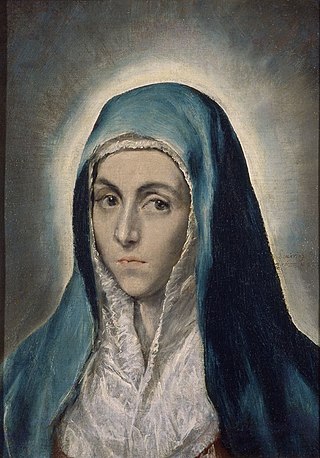
Doménikos Theotokópoulos, most widely known as El Greco, was a Greek painter, sculptor and architect of the Spanish Renaissance. El Greco was a nickname, and the artist normally signed his paintings with his full birth name in Greek letters, often adding the word Κρής, which means "Cretan", in Ancient Greek.

Domenico Zampieri, known by the diminutive Domenichino after his shortness, was an Italian Baroque painter of the Bolognese School of painters.

View of Toledo, is one of the two surviving landscapes painted by El Greco, along with View and Plan of Toledo. View of Toledo is held by the Metropolitan Museum of Art in New York City.

Foros Timis Ston Greco is a classical album by Greek electronic composer and artist Vangelis. The title is an allusion to the man who inspired the composition, Dominikos Theotokópoulos, the Cretan-born painter and sculptor better known as El Greco.

The Opening of the Fifth Seal was painted in the last years of El Greco's life for a side-altar of the church of Saint John the Baptist outside the walls of Toledo. Before 1908, El Greco's painting had been referred to as Profane Love. The scholar Manuel B. Cossio had doubts about the title and suggested the Opening of the Fifth Seal. The Metropolitan Museum, where the painting is kept, comments: "the picture is unfinished and much damaged and abraded."

The Assumption of the Virgin is an oil on canvas painting by Greek artist Doménikos Theotokópoulos, known as El Greco, in 1577–1579. The painting was a central element of the altarpiece of the church of Santo Domingo el Antiguo in Toledo, Spain. It was the first of nine paintings that El Greco was commissioned to paint for this church. The Assumption of the Virgin was El Greco's first work in Toledo and started his 37-year career there. Under the influence of Michelangelo, El Greco created a painting that in essence was Italian, with a naturalistic style, monumental figures, and a Roman school palette. The composition of El Greco's depiction of the Assumption of the Virgin resembles Titian's Assumption in the Basilica dei Frari in Venice with Virgin Mary and angels above and the apostles below. On the painting Virgin Mary floats upward which symbolizes her purity, while apostles gathered around her empty tomb express amazement and concern.

Art Heist is a 2004 action thriller film directed by Bryan Goeres and starring William Baldwin, Ellen Pompeo, and Abel Folk. Written by Diane Fine and Evan Spiliotopoulos, and produced by Manual Corbi, it was released on July 13, 2004.

Gaspar de Quiroga y Vela was a prominent Catholic official who rose to become General Inquisitor of Spain, from 1573 to 1594, and Archbishop of Toledo from 1577 to 1594. He was named a Cardinal by Pope Gregory XIII in 1578. He was the nephew of the 1st Bishop of Michoacán, Mexico, Vasco de Quiroga,.

The Modena Triptych is 1568 triptych by the artist El Greco, who was also known as Doménikos Theotokópoulos.

Saint Peter and Saint Paul is a painting by the Cretan-Spanish artist El Greco. The work was completed between 1590 and 1600. It is currently on display at the Museu Nacional d'Art de Catalunya, who purchased the work in 1932.

The El Greco Museum is a single-artist museum in Toledo, Spain, devoted to the work and life of El Greco, who spent much of his life in Toledo, having been born in Fodele, Crete. It is one of the National Museums of Spain and it is attached to the Ministry of Culture.

View and Plan of Toledo is a landscape painting by El Greco. The image is notable for its juxtaposition of the view of Toledo with the trompe l'oeil map of the city's streets. In the composition, El Greco also included an allegory of the Tagus River, a scene of the Virgin Mary placing a chasuble on Saint Ildefonsus, and an elevation of the Tavera Hospital floating on a cloud. It was probably originally commissioned by Pedro Salazar de Mendoza and is currently preserved in the El Greco Museum in Toledo, Spain.

Saint Sebastian, or Martyrdom of Saint Sebastian is an autograph work by the famed artist Doménikos Theotokópoulos, commonly known as El Greco. It shows the Martyred Saint in an atypical kneeling posture which has led some scholars to believe it to be a compositional quotation of various works by other great masters whom the artist admired. The painting is currently on display in the Palencia Cathedral.

The Adoration of the Shepherds is a painting of the traditional subject which was painted by El Greco in 1596. It is in the European painting collection of the National Museum of Art of Romania. This unusually tall painting is a work in the group of equally tall paintings which the artist made as part of his 1596 commission known as the Doña María de Aragón Altarpiece for the Colegio de Dona Maria de Aragón in a building that is now the location of Palacio del Senado in Madrid. El Greco's signature, in Greek, may be seen on the paper in the lower left corner.

Christ Carrying the Cross is an oil painting by El Greco, produced early in his Toledo period circa de 1580. The picture depicts Christ in a moment of personal reflection as he carries the cross to his death, therefore committing the ultimate sacrifice for humankind. In the painting, Christ's eyes are lifted up to the heavens as he begins his walk towards his crucifixion. His gentle hands wrap around the cross as a stormy night floods the background. Christ Carrying the Cross is an oil painting, 105x79cm. The painting, one of numerous similar paintings by El Greco, is currently in the El Greco room in the New York art collection of the Metropolitan Museum of Art.

The Virgin Mary, also known as Mater Dolorosa, although this title is now considered misleading, is a late 1590s or early 1600s painting by the Greek born, Spanish Mannerist painter Doménikos Theotokópoulos. It is on display in the Musée des Beaux-Arts of Strasbourg, France. Its inventory number is 276. A similar looking canvas in the Museo del Prado is considered a weaker replica.

Italo-Byzantine is a style term in art history, mostly used for medieval paintings produced in Italy under heavy influence from Byzantine art. It initially covers religious paintings copying or imitating the standard Byzantine icon types, but painted by artists without a training in Byzantine techniques. These are versions of Byzantine icons, most of the Madonna and Child, but also of other subjects; essentially they introduced the relatively small portable painting with a frame to Western Europe. Very often they are on a gold ground. It was the dominant style in Italian painting until the end of the 13th century, when Cimabue and Giotto began to take Italian, or at least Florentine, painting into new territory. But the style continued until the 15th century and beyond in some areas and contexts.

Christ Taking Leave of his Mother is a 1595 oil on canvas painting by a Greek artist Theotokopoulos Domenikos, better known as El Greco. The painting represents the first depiction of the subject by the artist.





















